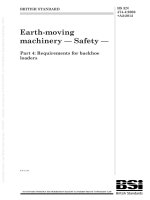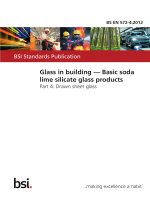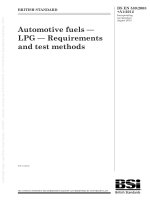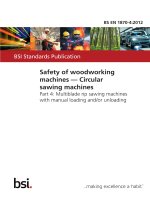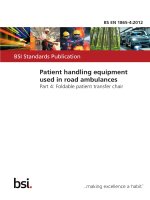Bsi bs en 61158 4 21 2012 (2013)
Bạn đang xem bản rút gọn của tài liệu. Xem và tải ngay bản đầy đủ của tài liệu tại đây (1.85 MB, 110 trang )
BS EN 61158-4-21:2012
Incorporating corrigendum June 2013
BSI Standards Publication
Industrial communication
networks — Fieldbus
specifications
Part 4-21: Data-link layer protocol
specification — Type 21 elements
BS EN 61158-4-21:2012 BRITISH STANDARD
National foreword
This British Standard is the UK implementation of EN 61158-4-21:2012. It
is identical to IEC 61158-4-21:2010. Together with
BS EN 61158-3-21:2012, BS EN 61158-5-21:2012 and
BS EN 61158-6-21:2012, it supersedes DD IEC/PAS 62573:2008, which is
withdrawn.
The UK participation in its preparation was entrusted to Technical Com-
mittee AMT/7, Industrial communications: process measurement and
control, including fieldbus.
A list of organizations represented on this committee can be obtained
on request to its secretary.
This publication does not purport to include all the necessary provisions
of a contract. Users are responsible for its correct application.
© The British Standards Institution 2013.
Published by BSI Standards Limited 2013
ISBN 978 0 580 79704 0
ICS 25.040.40; 33.040.40; 35.100.20
Compliance with a British Standard cannot confer immunity from
legal obligations.
This British Standard was published under the authority of the Standards
Policy and Strategy Committee on 30 June 2012.
Amendments/corrigenda issued since publication
Date Text affected
31 July 2013 Correction to supersession information in the
national foreword
EUROPEAN STANDARD BS EN 61158-4-21:2012
NORME EUROPÉENNE
EUROPÄISCHE NORM EN 61158-4-21
ICS 25.040.40; 35.100.20; 35.110 May 2012
English version
Industrial communication networks -
Fieldbus specifications -
Part 4-21: Data-link layer protocol specification -
Type 21 elements
(IEC 61158-4-21:2010)
Réseaux de communication industriels - Industrielle Kommunikationsnetze -
Spécifications des bus de terrain - Feldbusse -
Partie 4-21: Spécification du protocole de Teil 4-21: Protokollspezifikation des Data
la couche de liaison de données - Link Layer (Sicherungsschicht) -
Eléments de Type 21 Typ 21-Elemente
(CEI 61158-4-21:2010) (IEC 61158-4-21:2010)
This European Standard was approved by CENELEC on 2012-03-28. CENELEC members are bound to comply
with the CEN/CENELEC Internal Regulations which stipulate the conditions for giving this European Standard
the status of a national standard without any alteration.
Up-to-date lists and bibliographical references concerning such national standards may be obtained on
application to the CEN-CENELEC Management Centre or to any CENELEC member.
This European Standard exists in three official versions (English, French, German). A version in any other
language made by translation under the responsibility of a CENELEC member into its own language and notified
to the CEN-CENELEC Management Centre has the same status as the official versions.
CENELEC members are the national electrotechnical committees of Austria, Belgium, Bulgaria, Croatia, Cyprus,
the Czech Republic, Denmark, Estonia, Finland, France, Germany, Greece, Hungary, Iceland, Ireland, Italy,
Latvia, Lithuania, Luxembourg, Malta, the Netherlands, Norway, Poland, Portugal, Romania, Slovakia, Slovenia,
Spain, Sweden, Switzerland, Turkey and the United Kingdom.
CENELEC
European Committee for Electrotechnical Standardization
Comité Européen de Normalisation Electrotechnique
Europäisches Komitee für Elektrotechnische Normung
Management Centre: Avenue Marnix 17, B - 1000 Brussels
© 2012 CENELEC - All rights of exploitation in any form and by any means reserved worldwide for CENELEC members.
Ref. No. EN 61158-4-21:2012 E
BS EN 61158-4-21:2012
EN 61158-4-21:2012 - 2 -
Foreword
The text of document 65C/605/FDIS, future edition 1 of IEC 61158-4-21, prepared by SC 65C, "Industrial
networks", of IEC/TC 65, "Industrial-process measurement, control and automation" was submitted to the
IEC-CENELEC parallel vote and approved by CENELEC as EN 61158-4-21:2012.
The following dates are fixed:
• latest date by which the document has (dop) 2012-12-28
to be implemented at national level by (dow) 2015-03-28
publication of an identical national
standard or by endorsement
• latest date by which the national
standards conflicting with the
document have to be withdrawn
Attention is drawn to the possibility that some of the elements of this document may be the subject of
patent rights. CENELEC [and/or CEN] shall not be held responsible for identifying any or all such patent
rights.
Endorsement notice
The text of the International Standard IEC 61158-4-21:2010 was approved by CENELEC as a European
Standard without any modification.
In the official version, for Bibliography, the following notes have to be added for the standards indicated:
IEC/TR 61158-1:2010 NOTE Harmonized as CLC/TR 61158-1:2010 (not modified).
IEC 61158-2:2010 NOTE Harmonized as EN 61158-2:2010 (not modified).
IEC 61158-5-21:2010 NOTE Harmonized as EN 61158-5-21:2012 (not modified).
IEC 61158-6-21:2010 NOTE Harmonized as EN 61158-6-21:2012 (not modified).
BS EN 61158-4-21:2012
- 3 - EN 61158-4-21:2012
Annex ZA
(normative)
Normative references to international publications
with their corresponding European publications
The following documents, in whole or in part, are normatively referenced in this document and are
indispensable for its application. For dated references, only the edition cited applies. For undated
references, the latest edition of the referenced document (including any amendments) applies.
NOTE When an international publication has been modified by common modifications, indicated by (mod), the relevant EN/HD
applies.
Publication Year Title EN/HD Year
IEC 61158-3-21 2010 2012
ISO/IEC 7498-1 - Industrial communication networks - Fieldbus EN 61158-3-21 -
ISO/IEC 7498-3 - specifications - -
ISO/IEC 8802-3 2000 Part 3-21: Data-link layer service definition - -
Type 21 elements
ISO/IEC 10731 1994 -
Information technology - Open Systems -
Interconnection - Basic Reference Model:
The Basic Model
Information technology - Open Systems -
Interconnection - Basic Reference Model:
Naming and addressing
Information technology - Telecommunications -
and information exchange between systems -
Local and metropolitan area networks -
Specific requirements -
Part 3: Carrier sense multiple access with
collision detection (CSMA/CD) access method
and physical layer specifications
Information technology - Open Systems -
Interconnection - Basic reference model -
Conventions for the definition of OSI services
– 2 – BS EN 61158-4-21:2012
61158-4-21 © IEC:2010(E)
CONTENTS
INTRODUCTION ..................................................................................................................... 8
1 Scope............................................................................................................................. 10
1.1 General .................................................................................................................10
1.2 Specifications........................................................................................................10
1.3 Procedures............................................................................................................10
1.4 Applicability...........................................................................................................10
1.5 Conformance.........................................................................................................11
2 Normative references .....................................................................................................11
3 Terms, definitions, symbols and abbreviations................................................................ 11
3.1 Reference model terms and definitions..................................................................11
3.2 Service convention terms and definitions............................................................... 13
3.3 Common terms and definitions ..............................................................................14
3.4 Symbols and abbreviations.................................................................................... 17
4 Overview of the data-link protocol...................................................................................18
4.1 General .................................................................................................................18
4.2 Overview of medium access control ......................................................................18
4.3 Service assumed from the physical layer ............................................................... 19
4.4 DLL architecture....................................................................................................19
4.5 Data type ..............................................................................................................21
4.6 Local parameters and variables.............................................................................23
5 General structure and encoding......................................................................................38
5.1 Overview ...............................................................................................................38
5.2 MAPDU structure and encoding.............................................................................38
5.3 Common MAC frame structure, encoding and elements of procedure .................... 39
5.4 Order of bit transmission .......................................................................................47
5.5 Invalid DLPDU.......................................................................................................47
6 DLPDU structure and procedure .....................................................................................48
6.1 General .................................................................................................................48
6.2 Common DLPDU Field ..........................................................................................48
6.3 DL-DATA Transfer.................................................................................................48
6.4 DL-SPDATA Transfer ............................................................................................51
6.5 Network control messages ....................................................................................53
7 DLE elements of procedure ............................................................................................59
7.1 Overall structure....................................................................................................59
7.2 DL-protocol machine (DLPM) ................................................................................59
7.3 DLL management Protocol ....................................................................................69
8 Constants and error codes ........................................................................................... 102
8.1 General ............................................................................................................... 102
8.2 Constants............................................................................................................ 102
8.3 Data-link layer error codes .................................................................................. 104
Bibliography........................................................................................................................ 105
Figure 1 – Relationships of DLSAPs, DLSAP-addresses, and group DL-addresses ............... 15
Figure 2 – Interaction of PhS primitives with DLE.................................................................. 19
BS EN 61158-4-21:2012 – 3 –
61158-4-21 © IEC:2010(E)
Figure 3 – Data-link layer architecture .................................................................................. 20
Figure 4 – Common MAC frame format for Type 21 DLPDU .................................................. 39
Figure 5 – MAC frame format for other protocols...................................................................39
Figure 6 – Version and Length field ......................................................................................40
Figure 7 – DST_addr field .....................................................................................................41
Figure 8 – SRC_addr field.....................................................................................................42
Figure 9 – Frame Control Field .............................................................................................43
Figure 10 – Extension field ...................................................................................................45
Figure 11 – DSAP field .........................................................................................................46
Figure 12 – Source service access point field .......................................................................46
Figure 13 – Length of group mask and extension information................................................ 47
Figure 14 – Group mask option field .....................................................................................47
Figure 15 – Common DLPDU field ........................................................................................48
Figure 16 – Building a DT DLPDU.........................................................................................49
Figure 17 – DT DLPDU structure ..........................................................................................49
Figure 18 – SPDT DLPDU structure ......................................................................................52
Figure 19 – NCM_LA DLPDU structure .................................................................................54
Figure 20 – DLL structure and elements ...............................................................................59
Figure 21 – State transition diagram of the DLPM .................................................................63
Figure 22 – State transition diagram of DLM .........................................................................73
Table 1 – DLL components ...................................................................................................20
Table 2 – UNSIGNEDn data type ......................................................................................... 22
Table 3 – INTEGERn data type .............................................................................................23
Table 4 – DLE configuration parameters ...............................................................................24
Table 5 – Queues to support data transfer ............................................................................25
Table 6 – Variables to support SAP management ................................................................. 26
Table 7 – Variables to support device information management ............................................ 26
Table 8 – DL–entity identifier ................................................................................................27
Table 9 – Device Flags .........................................................................................................27
Table 10 – DLM state............................................................................................................ 27
Table 11 – Device Unique Identification ................................................................................28
Table 12 – Unique identification of device connected to R-port1 ........................................... 28
Table 13 – Unique identification of device connected to R-port2 ........................................... 28
Table 14 – MAC address.......................................................................................................28
Table 15 – Port information...................................................................................................29
Table 16 – Protocol version ..................................................................................................29
Table 17 – Device type .........................................................................................................30
Table 18 – Device description ...............................................................................................30
Table 19 – Hop count............................................................................................................ 30
Table 20 – Variables to support managing network information............................................. 31
Table 21 – Topology ............................................................................................................. 31
Table 22 – Collision count.....................................................................................................31
– 4 – BS EN 61158-4-21:2012
61158-4-21 © IEC:2010(E)
Table 23 – Device count .......................................................................................................32
Table 24 – Topology change count .......................................................................................32
Table 25 – Last topology change time...................................................................................32
Table 26 – RNMP device UID ...............................................................................................32
Table 27 – RNMS device UID ...............................................................................................33
Table 28 – LNM device UID for R-port1 ................................................................................33
Table 29 – LNM device UID for R-port2 ................................................................................33
Table 30 – Network flags ......................................................................................................34
Table 31 – Variables and counter to support managing path information............................... 35
Table 32 – Hop count for R-port1 direction............................................................................ 36
Table 33 – Hop count for R-port2 direction............................................................................ 36
Table 34 – Preferred R-port ..................................................................................................36
Table 35 – Destination R-port ...............................................................................................36
Table 36 – In net count ......................................................................................................... 37
Table 37 – In net time ........................................................................................................... 37
Table 38 – Out net count ......................................................................................................38
Table 39 – Out net time ........................................................................................................38
Table 40 – Version and Length .............................................................................................41
Table 41 – Destination DL–entity identifier ............................................................................41
Table 42 – Source DL–entity identifier ..................................................................................42
Table 43 – Frame control ......................................................................................................43
Table 44 – Extension ............................................................................................................ 45
Table 45 – Destination service access point .........................................................................46
Table 46 – source service access point.................................................................................46
Table 47 – DT DLPDU parameters ........................................................................................49
Table 48 – Primitives exchanged between DLS-user and DLE to send a DT DLPDU ............. 51
Table 49 – Primitives exchanged between DLS-user and DLEs to receive a DT DLPDU ....... 51
Table 50 – SPDT DLPDU Parameters ...................................................................................52
Table 51 – Primitive exchanged between DLS-User and DLEs to send an SPDT
DLPDU ................................................................................................................................. 53
Table 52 – Primitives exchanged between DLS-user and DLEs to receive an SPDT
DLPDU ................................................................................................................................. 53
Table 53 – NCM_LA DLPDU parameters...............................................................................54
Table 54 – NCM_AT DLPDU parameters ..............................................................................55
Table 55 – NCM_LS DLPDU parameters...............................................................................56
Table 56 – NCM_RS DLPDU parameters ..............................................................................57
Table 57 – NCM_AR DLPDU parameters ..............................................................................58
Table 58 – Primitives exchanged between DLPM and DLS-user............................................60
Table 59 – Parameters exchanged between DLPM and DLS-user ......................................... 61
Table 60 – Primitives exchanged between DLPM and DLM ...................................................62
Table 61 – Parameters used with primitives exchanged between DLPM and DLM................. 63
Table 62 – DLPM state table.................................................................................................64
Table 63 – DLPM functions table ..........................................................................................68
Table 64 – Primitives exchanged between DLM and DLS-user ..............................................70
BS EN 61158-4-21:2012 – 5 –
61158-4-21 © IEC:2010(E)
Table 65 – Parameters used with primitives exchanged between DLM and DLS-user............ 71
Table 66 – Primitive exchanged between DLM and DMAC ....................................................71
Table 67 – Parameters used with primitives exchanged between DLM and DMAC ................ 72
Table 68 – Primitive exchanged between DLM and DPHY.....................................................72
Table 69 – Parameters used with primitives exchanged between DLM and DPHY................. 72
Table 70 – DLM state table ...................................................................................................75
Table 71 – DLM function table ............................................................................................ 100
Table 72 – DLL constants ................................................................................................... 103
Table 73 – Type 21 DLL error codes ................................................................................... 104
– 8 – BS EN 61158-4-21:2012
61158-4-21 © IEC:2010(E)
INTRODUCTION
This part of IEC 61158 is one of a series produced to facilitate the interconnection of
automation system components. It is related to other standards in the set as defined by the
“three-layer” fieldbus reference model described in IEC/TR 61158-1.
The data-link protocol provides the data-link service by making use of the services available
from the physical layer. The primary aim of this standard is to provide a set of rules for
communication expressed in terms of the procedures to be carried out by peer data-link
entities (DLEs) at the time of communication. These rules for communication are intended to
provide a sound basis for development in order to serve a variety of purposes:
a) as a guide for implementors and designers;
b) for use in the testing and procurement of equipment;
c) as part of an agreement for the admittance of systems into the open systems environment;
d) as a refinement to the understanding of time-critical communications within OSI.
This standard is concerned, in particular, with the communication and interworking of sensors,
effectors and other automation devices. By using this standard together with other standards
positioned within the OSI or fieldbus reference models, otherwise incompatible systems may
work together in any combination.
NOTE Use of some of the associated protocol types is restricted by their intellectual-property-right holders. In all
cases, the commitment to limited release of intellectual-property-rights made by the holders of those rights permits
a particular data-link layer protocol type to be used with physical layer and application layer protocols in type
combinations as specified explicitly in the profile parts. Use of the various protocol types in other combinations
may require permission of their respective intellectual-property-right holders.
The International Electrotechnical Commission (IEC) draws attention to the fact that it is
claimed that compliance with this document may involve the use of patents concerning
Type 21 elements and possibly other types given in subclause 4.1, 4.2 and 7.3 as follows:
KR 0789444 [LS] A communication packet processing apparatus and method for
ring topology ethernet network capable of preventing permanent
KR 0732510 packet looping
KR 0870670
[LS] Network system
[LS] Method for determining a Ring Manager Node
IEC takes no position concerning the evidence, validity and scope of these patent rights.
The holder of these patent rights has assured the IEC that he/she is willing to negotiate
licences either free of charge or under reasonable and non-discriminatory terms and
conditions with applicants throughout the world. In this respect, the statement of the holder of
these patent rights is registered with IEC. Information may be obtained from:
[LS]: LS Industrial Systems Co., Ltd.
LS Tower 1026-6
Hogye-dong, Dongan-gu,
Anyang-si, Gyeonggi-do 431-848
Republic of Korea
Attention is drawn to the possibility that some of the elements of this document may be the
subject of patent rights other than those identified above. IEC shall not be held responsible for
identifying any or all such patent rights.
BS EN 61158-4-21:2012 – 9 –
61158-4-21 © IEC:2010(E)
ISO (www.iso.org/patents) and IEC ( maintain on-
line data bases of patents relevant to their standards. Users are encouraged to consult the
data bases for the most up to date information concerning patents.
– 10 – BS EN 61158-4-21:2012
61158-4-21 © IEC:2010(E)
INDUSTRIAL COMMUNICATION NETWORKS –
FIELDBUS SPECIFICATIONS –
Part 4-21: Data-link layer protocol specification –
Type 21 elements
1 Scope
1.1 General
The DLL provides basic time-critical data communications between devices in an automated
environment. Type 21 provides priority-based cyclic and acyclic data communication using an
internal collision-free, full-duplex dual-port Ethernet switch technology. For wide application in
various automation applications, Type 21 does not restrict the cyclic/acyclic scheduling policy
in the DLL.
1.2 Specifications
This standard describes:
a) procedures for the timely transfer of data and control information from one data link
user entity to a peer user entity, and among the data link entities forming the
distributed data link service provider;
b) procedures for giving communication opportunities based on standard ISO/IEC 8802-3
MAC, with provisions for nodes to be added or removed during normal operation;
c) structure of the fieldbus data link protocol data units (DLPDUs) used for the transfer
of data and control information by the protocol of this standard, and their
representation as physical interface data units.
1.3 Procedures
The procedures are defined in terms of:
a) the interactions between peer data link entities (DLEs) through the exchange of
fieldbus DLPDUs;
b) the interactions between a data link service (DLS) provider and a DLS-user in the
same system through the exchange of DLS primitives;
c) the interactions between a DLS-provider and a physical layer service provider in the
same system through the exchange of Ph-service primitives.
1.4 Applicability
These procedures are applicable to instances of communication between systems that
support time-critical communications services in the data link layer of the OSI or fieldbus
reference models, and that require the ability to interconnect in an open systems
interconnection environment. Profiles provide a simple multi-attribute means of summarizing
an implementation’s capabilities, and thus its applicability to various time-deterministic
communications needs.
BS EN 61158-4-21:2012 – 11 –
61158-4-21 © IEC:2010(E)
1.5 Conformance
This standard also specifies conformance requirements for systems implementing these
procedures. This standard does not contain tests to demonstrate compliance with such
requirements.
2 Normative references
The following referenced documents are indispensable for the application of this document.
For dated references, only the edition cited applies. For undated references, the latest edition
of the referenced document (including any amendments) applies.
IEC 61158-3-21:2010 1 , Industrial Communication Networks – Fieldbus specifications –
Part 3-21: Data-link layer service definition – Type 21 elements
ISO/IEC 7498-1, Information technology – Open Systems Interconnection – Basic Reference
Model: The Basic Model
ISO/IEC 7498-3, Information technology – Open Systems Interconnection – Basic Reference
Model: Naming and addressing
ISO/IEC 8802-3:2000, Information technology – Telecommunications and information
exchange between systems – Local and metropolitan area networks – Specific requirements –
Part 3: Carrier sense multiple access with collision detection (CSMA/CD) access method and
physical layer specifications
ISO/IEC 10731:1994, Information technology – Open Systems Interconnection – Basic
Reference Model – Conventions for the definition of OSI services
3 Terms, definitions, symbols and abbreviations
For the purposes of this document, the following terms, definitions, symbols, abbreviations,
and conventions apply.
3.1 Reference model terms and definitions
This standard is based in part on the concepts developed in ISO/IEC 7498-1 and
ISO/IEC 7498-3, and makes use of the following terms defined therein.
3.1.1 called-DL-address [ISO/IEC 7498-3]
[ISO/IEC 7498-3]
3.1.2 calling-DL-address [ISO/IEC 7498-1]
[ISO/IEC 7498-1]
3.1.3 centralized multi-end-point-connection
[ISO/IEC 7498-1]
3.1.4 correspondent (N)-entities [ISO/IEC 7498-3]
correspondent DL-entities (N=2) [ISO/IEC 7498-1]
correspondent Ph-entities (N=1)
3.1.5 demultiplexing
3.1.6 DL-address
3.1.7 DL-address-mapping
—————————
1 To be published.
– 12 – BS EN 61158-4-21:2012
61158-4-21 © IEC:2010(E)
3.1.8 DL-connection
3.1.9 DL-connection-end-point [ISO/IEC 7498-1]
3.1.10 DL-connection-end-point-identifier [ISO/IEC 7498-1]
3.1.11 DL-connection-mode transmission [ISO/IEC 7498-1]
3.1.12 DL-connectionless-mode transmission [ISO/IEC 7498-1]
3.1.13 DL-data-sink [ISO/IEC 7498-1]
3.1.14 DL-data-source [ISO/IEC 7498-1]
3.1.15 DL-duplex-transmission [ISO/IEC 7498-1]
3.1.16 DL-facility [ISO/IEC 7498-1]
3.1.17 DL-local-view [ISO/IEC 7498-1]
3.1.18 DL-name [ISO/IEC 7498-3]
3.1.19 DL-protocol [ISO/IEC 7498-3]
3.1.20 DL-protocol-connection-identifier [ISO/IEC 7498-1]
3.1.21 DL-protocol-control-information [ISO/IEC 7498-1]
3.1.22 DL-protocol-data-unit [ISO/IEC 7498-1]
3.1.23 DL-protocol-version-identifier [ISO/IEC 7498-1]
3.1.24 DL-relay [ISO/IEC 7498-1]
3.1.25 DL-service-connection-identifier [ISO/IEC 7498-1]
3.1.26 DL-service-data-unit [ISO/IEC 7498-1]
3.1.27 DL-simplex-transmission [ISO/IEC 7498-1]
3.1.28 DL-subsystem [ISO/IEC 7498-1]
3.1.29 DL-user-data [ISO/IEC 7498-1]
3.1.30 flow control [ISO/IEC 7498-1]
3.1.31 layer-management [ISO/IEC 7498-1]
3.1.32 multiplexing [ISO/IEC 7498-1]
3.1.33 naming-(addressing)-authority [ISO/IEC 7498-3]
3.1.34 naming-(addressing)-domain [ISO/IEC 7498-3]
3.1.35 naming-(addressing)-subdomain [ISO/IEC 7498-3]
3.1.36 (N)-entity [ISO/IEC 7498-3]
[ISO/IEC 7498-1]
DL-entity
Ph-entity [ISO/IEC 7498-1]
3.1.37 (N)-interface-data-unit
DL-service-data-unit (N=2)
Ph-interface-data-unit (N=1)
BS EN 61158-4-21:2012 – 13 –
61158-4-21 © IEC:2010(E)
3.1.38 (N)-layer [ISO/IEC 7498-1]
DL-layer
Ph-layer (N=2) [ISO/IEC 7498-1]
(N=1)
[ISO/IEC 7498-1]
3.1.39 (N)-service
DL-service (N=2) [ISO/IEC 7498-1]
Ph-service (N=1)
[ISO/IEC 7498-1]
3.1.40 (N)-service-access-point [ISO/IEC 7498-1]
DL-service-access-point [ISO/IEC 7498-1]
Ph-service-access-point (N=2) [ISO/IEC 7498-3]
(N=1) [ISO/IEC 7498-1]
[ISO/IEC 7498-1]
3.1.41 (N)-service-access-point-address [ISO/IEC 7498-1]
DL-service-access-point-address [ISO/IEC 7498-3]
Ph-service-access-point-address (N=2) [ISO/IEC 7498-1]
(N=1) [ISO/IEC 7498-1]
[ISO/IEC 7498-1]
3.1.42 peer-entities [ISO/IEC 7498-1]
[ISO/IEC 7498-3]
3.1.43 Ph-interface-control-information [ISO/IEC 7498-1]
3.1.44 Ph-interface-data
3.1.45 primitive name
3.1.46 reassembling
3.1.47 recombining
3.1.48 reset
3.1.49 responding-DL-address
3.1.50 routing
3.1.51 segmenting
3.1.52 sequencing
3.1.53 splitting
3.1.54 synonymous name
3.1.55 systems-management
3.2 Service convention terms and definitions
This standard also makes use of the following terms defined in ISO/IEC 10731 as they apply
to the data-link layer:
– 14 – BS EN 61158-4-21:2012
61158-4-21 © IEC:2010(E)
3.2.1 acceptor
3.2.2 asymmetrical service
3.2.3 confirm (primitive);
requestor.deliver (primitive)
3.2.4 deliver (primitive)
3.2.5 DL-confirmed-facility
3.2.6 DL-facility
3.2.7 DL-local-view
3.2.8 DL-mandatory-facility
3.2.9 DL-non-confirmed-facility
3.2.10 DL-protocol-machine
3.2.11 DL-provider-initiated-facility
3.2.12 DL-provider-optional-facility
3.2.13 DL-service-primitive;
primitive
3.2.14 DL-service-provider
3.2.15 DL-service-user
3.2.16 DLS-user-optional-facility
3.2.17 indication (primitive);
acceptor.deliver (primitive)
3.2.18 multi-peer
3.2.19 request (primitive);
requestor.submit (primitive)
3.2.20 requestor
3.2.21 response (primitive);
acceptor.submit (primitive)
3.2.22 submit (primitive)
3.2.23 symmetrical service
3.3 Common terms and definitions
NOTE Many definitions are common to more than one protocol Type; they are not necessarily used by all protocol
Types.
3.3.1
DL-segment, link, local link
single data link (DL) subnetwork in which any of the connected data link entities (DLEs) may
communicate directly, without any intervening data link relaying, whenever all of those DLEs
that are participating in an instance of communication are simultaneously attentive to the
DL-subnetwork during the period(s) of attempted communication
3.3.2
data-link service access point (DLSAP)
distinctive point at which DL-services are provided by a single DLE to a single higher-layer
entity
NOTE This definition, derived from ISO/IEC 7498-1, is repeated here to facilitate understanding of the critical
distinction between DLSAPs and their DL-addresses.(See Figure 1.)
BS EN 61158-4-21:2012 – 15 –
61158-4-21 © IEC:2010(E)
DLS-use rs DLS-user-entity DLS-user-entity
DLSAP DLSAP DLSAP
DLSAP- DLSAP- group DL- DLSAP-
addresses address address address
DL-layer DL-entity
PhSA P PhSA P
Ph-layer
NOTE 1 DLSAPs and physical layer service access points (PhSAPs) are depicted as ovals spanning the boundary
between two adjacent layers.
NOTE 2 DL-addresses are depicted as designating small gaps (points of access) in the DLL portion of a DLSAP.
NOTE 3 A single DLE may have multiple DLSAP-addresses and group DL-addresses associated with a single
DLSAP.
Figure 1 – Relationships of DLSAPs, DLSAP-addresses, and group DL-addresses
3.3.3
DL(SAP) -address
either an individual DLSAP address designating a single DLSAP of a single data link service
(DLS) user (DLS-user), or a group DL-address potentially designating multiple DLSAPs, each
of a single DLS-user
NOTE This terminology was chosen because ISO/IEC 7498-3 does not permit the use of the term DLSAP-address
to designate more than a single DLSAP at a single DLS-user.
3.3.4
(individual) DLSAP-address
DL-address that designates only one DLSAP within the extended link
NOTE A single DL-entity may have multiple DLSAP-addresses associated with a single DLSAP.
3.3.5
Data-link connection endpoint address (DLCEP-address)
DL-address that designates either:
a) one peer DL-connection-end-point;
b) one multi-peer publisher DL-connection-end-point, and implicitly the corresponding set of
subscriber DL-connection-end-points, where each DL-connection-end-point exists within a
distinct DLSAP and is associated with a corresponding distinct DLSAP-address.
3.3.6
Frame check sequence (FCS) error
error that occurs when the computed frame check sequence value after reception of all the
octets in a data link protocol data unit (DLPDU) does not match the expected residual
– 16 – BS EN 61158-4-21:2012
61158-4-21 © IEC:2010(E)
3.3.7
frame
synonym for DLPDU
3.3.8
network management
management functions and services that perform network initialization, configuration, and
error handling
3.3.9
protocol
convention on the data formats, time sequences, and error correction for data exchange in
communication systems
3.3.10
receiving DLS-user
DL-service user that acts as a recipient of DLS-user data
NOTE A DL-service user can be both a sending and receiving DLS-user concurrently.
3.3.11
sending DLS-user
DL-service user that acts as a source of DLS-user data
3.3.12
device
single DLE as it appears on one local link
3.3.13
DL– entity identifier
address that designates the (single) DLE associated with a single device on a specific local
link
3.3.14
device unique identification
unique 8 octet identification to identify a Type 21 device in a network. This ID is a combination
of a 6 octet ISO/IEC 8802-3:2000 MAC address and 2 octet DL-address
3.3.15
ring
active network where each node is connected in series to two other devices
NOTE A ring may also be referred to as a loop.
3.3.16
linear topology
topology where the devices are connected in series, with two devices each connected to only
one other device, and all others each connected to two other devices, for example, connected
in a line
3.3.17
R-port
port in a communication device that is part of a ring structure
3.3.18
real-time
ability of a system to provide a required result in a bounded time
BS EN 61158-4-21:2012 – 17 –
61158-4-21 © IEC:2010(E)
3.3.19
real-time communication
transfer of data in real-time
3.3.20
Real-time Ethernet (RTE)
ISO/IEC 8802-3:2000 based network that includes real-time communication
NOTE 1 Other communications can be supported, providing that the real-time communication is not compromised.
NOTE 2 This definition is base on, but not limited to, ISO/IEC 8802-3:2000. It could be applicable to other
IEEE802 specifications, e.g., IEEE802.11.
3.3.21
RTE end device
device with at least one active RTE port
3.3.22
RTE port
media access control (MAC) sublayer point where an RTE is attached to a local area network
(LAN)
NOTE This definition is derived from that of bridge port in ISO/IEC 10038: 1993, as applied to local MAC bridges.
3.3.23
switched network
network also containing switches
NOTE Switched network means that the network is based on IEEE802.1D and IEEE802.1Q with MAC bridges and
priority operations.
3.3.24
link
transmission path between two adjacent nodes [derived from ISO/IEC 11801]
3.4 Symbols and abbreviations
3.4.1 Common symbols and abbreviations
DL data link (used as a prefix or adjective)
DLC data link connection
DLCEP data link connection endpoint
DLE data link entity (the local active instance of the DLL)
DLL data link layer
DLPDU data link protocol data unit
DLPM data link protocol machine
DLM data link management
DLME data link management entity (the local active instance of DLM)
DLMS data link management service
DLS data link service
DLSAP data link service-access-point
DLSDU data link service-data-unit
FIFO first-in, first-out (queuing method)
NMT network management
OSI Open Systems Interconnection
– 18 – BS EN 61158-4-21:2012
61158-4-21 © IEC:2010(E)
physical layer (as a prefix)
Ph- physical interface transceiver
PHY physical layer
PhL Real-time Ethernet
RTE International Electrotechnical Commission
IEC Internet Protocol ( see RFC 791)
IP International Organization for Standardization
ISO media access control
MAC non-real-time
NRT protocol data unit
PDU service access point
SAP real-time
RT Transmission Control Protocol (see RFC 793)
TCP User Datagram Protocol (see RFC 768)
UDP
3.4.2 Type 21: Additional symbols and abbreviations
EFR extremely fast recovery
GD general device
LNM line network manager
PO power on
PnP plug and play
RNM ring network manager
RNMP primary ring network manager
RNMS secondary ring network manager
RNAC ring network auto configuration
UID device unique identification
Type 21 NMIB Type 21 network management information base
4 Overview of the data-link protocol
4.1 General
Type 21 extends Ethernet according to the ISO/IEC 8802-3:2000 standard with mechanisms
to transfer data with predictable timing demands typical of high-performance automation. It
does not change the basic principles of the Ethernet standard ISO/IEC 8802-3:2000 but
extends it toward RTE. Thus, it is possible to continue to use standard Ethernet hardware,
infrastructure components, or test and measurement equipment, such as network analyzers.
4.2 Overview of medium access control
A Type 21 device requires an integrated switch with two ports (ring ports) connected to the
ring. A Type 21 network system is constructed with full-duplex, collision-free Ethernet
switching devices as a ring or a line network. Type 21 guarantees collision-free data
transmission between two devices linked by a full-duplex Ethernet connection. Thus, the
Type 21 data link layer provides reliable, transparent and collision-free data transmission
among DLS-users.

